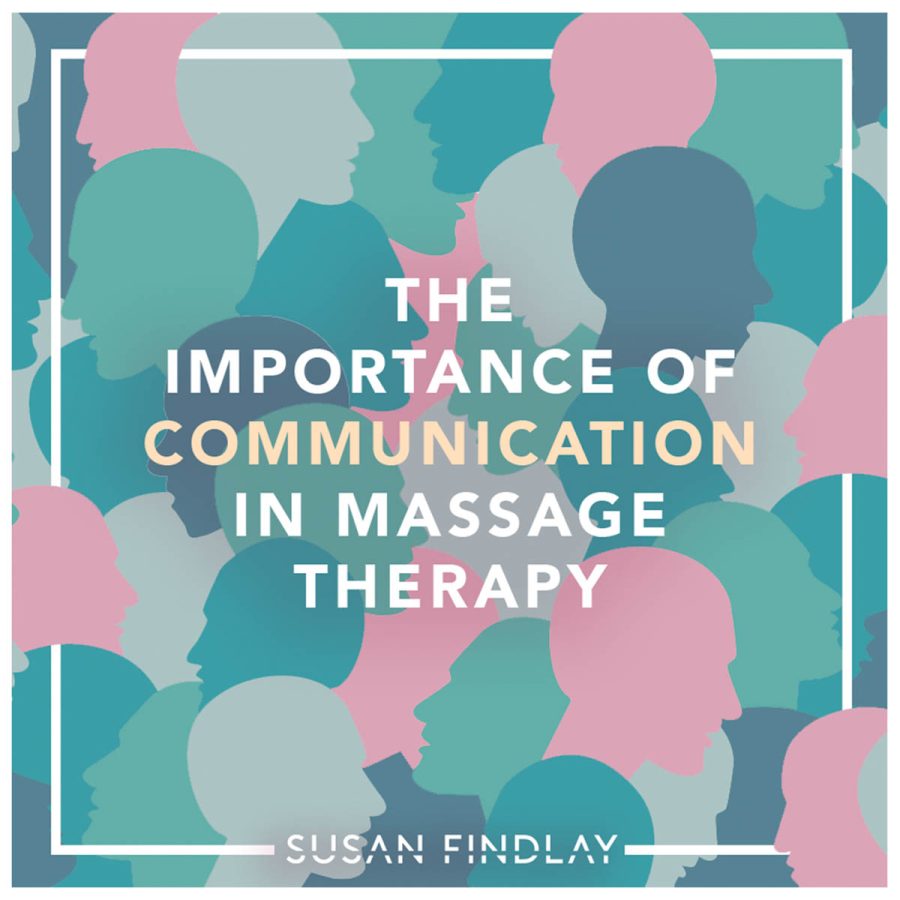It might seem obvious that if you improve your communication skills between yourself and your client it will lead to an increase in positive outcomes, but as massage therapists we often concentrate on our hands on skills and pay little attention to what we say, but what we say really can make a difference to the way the client perceives the service they have received and how they themselves can make positive changes.
The way in which we behave within our therapist/client relationship and the language we choose will influence the outcome of the session, as well as the client’s experience and the likelihood of them returning for future sessions. Therefore, it is obviously important that you as the professional be mindful and reflect on whether the language you use demonstrates confidence or puts limits on what can be achieved.
Let’s start with the interviewing process. The information a client provides prior to the massage should form the basis of your questions, this is the time in which you will be able to manage any expectations from the client and more importantly it’s the time for you to understand as accurately as possible the feelings of the client and their lifestyle. This is when initial decisions can be made in which you set goals that will meet their needs. If you understand your client’s priorities and can address them in the form of suggestions and massage skills, they will return.
During the all-important subjective stage, avoid using open ended, non-specific questions, instead guide the client to tell you in as much detail as possible their story. Sometimes in the initial consultation we do not have a lot of time to listen, in many clinics clients fill in a form that the therapist then looks over for anything that might prevent them from delivering a treatment or massage, they might spend a bit of time clarifying a few points, making sure there is nothing untoward before proceeding with the treatment. Is this enough? Do you think your client feels they’ve been heard?
Establishing their priorities and their reason(s) for coming to you is of the utmost importance. Do not assume you know and don’t be shy about asking them outright their reason for attending? What is their priority? What would they like you to focus on? If you are treating someone for a specific need, whether it is an injury, long term discomfort or emotional concerns, spending time within the massage addressing their priority will make them realise that you listened, acknowledged and addressed their concerns in your treatment. They will leave feeling they have been heard even if the issue has not been resolved.
Many of my clients come in with some discomfort or pain as their main issue, it is a big subject and can require a greater investment of time than many therapists can’t afford, but if I really want to help my client and make a difference I need to find out enough detail so that I understand what is really going on. Treat that and you will save time in the long run.
Not all clients are as articulate or forthcoming as we might like, so it is vital you allow them time to talk. It’s also vital that you don’t talk over your clients or finish their sentences if you really want to know why they have come to you. Plus, it’s just plain good manners! Try pausing for a second or two after your client has finished speaking, this way you’ll find out if they have really finished speaking……or do they have more to say? Silence is an important element of detective work and forms an invaluable component in the ability to listen. It demonstrates superior communication skills.
One of the techniques I use to establish an accurate understanding of my client is to repeat back the information to them using as best as I can their exact words, it’s an effective way for them to be able to clarify what they have said if needed. I am regularly surprised by the number of corrections a client will make when they hear their words being repeated back to them. I prefer this technique of communication over the traditional approach of summarizing, I think it is more effective when a client hears their own words, they know that their therapist understands them on a deeper level.
When discussing certain issues with clients we may need to choose our words sensitively, a client might inform you they have lower back issues and that they spend eight hours a day working at a computer but to you it’s obvious that they carry a lot of weight around their middle. A familiar scenario for many of you, I’m sure… You have a dilemma; do you tell your client to lose weight by going on a diet and exercising (without which nothing will change) or do you explore other options? Often when working on a client, I use the opportunity to explain the benefit of movement. In this case I have provided the movement passively but I also explain if they apply more movement in their day to day activities it could have a similar benefit. Without telling them to lose weight, exercise, change their lifestyle, I make suggestions that can easily be integrated in to their lives, something that will make them feel better, if that happens they will be more receptive to making other lifestyle changes without it seeming difficult. Later I might suggest they try something outside of work, but I will start with a simple mobility exercises they can do at their desks, later it will move onto bigger lifestyle changes such as trying something they have always wanted to do, maybe it is ballroom dancing, or cycling instead of driving or taking up a new hobby such as Yoga or Pilates for relaxation, while also strengthening the body. What they choose has to be fun, chores are difficult to keep up, hence it is important they look forward to it. This style of communication is likely to engage with the client far more effectively as it provides a gradual change and a wide range of innovative options that work alongside massage therapy.
When you want to express to the client what you are finding under your hands, be mindful of how this is communicated and be positive. For example, if an area of tension is identified which seems diabolically tight, so tight that no amount of massage will heal it, the professional should look at what can be achieved instead of giving an unfiltered commentary which might create a negative outlook and leave the client feeling anxious and uncomfortable. We have all had the scenario in which we find a line of tension in a muscle that almost ‘twangs’ under our hands. Do you comment ‘OMG that is so tight! No wonder you are in pain!’ or do you simply ease into the tension, allowing the tissue to soften and say ‘did you feel that release?’ In the first instance you are focusing on the problem, in the second you’re focusing on the solution. You have a choice, here is an opportunity to change your client’s perception, you can explore whether decreasing the amount of stress placed on the area can alter the perception of tension and give ease to the area or focus on the problem. By explaining this process and giving advice on how to maintain the improved level of comfort will convey a positive outcome and give your client hope for a better future.
Here is another example:
The client has presented with a right sided Frozen Shoulder, they’re in a significant amount of pain all the time, they’re not sleeping well because of it, they cannot lift their arm up to brush their teeth or put on a sweatshirt. They went to their GP and had a corticosteroid injection with no effect, they tried a variety of treatments but without success and they’re desperate to get some relief. You know this type of condition can take many years to resolve, that pain is part of the deal and most therapies do not work but you have had success with this condition in the past, not necessarily resolving it but being able to provide symptom relief.
In this example it is beneficial to the client and your relationship with them for you to focus on the successful elements of the previous time you dealt with the issue, emphasizing and outlining the symptom relief that you can provide in a detailed plan, along with self-care methods they can use, so they feel they are in control, as well as feeling comfortable and confident in the therapy you provide. It is important to be authentic and genuine with your client, so explaining in a rephrased fashion that the journey to resolution will be a long one, and outlining the need for open and understanding communication to find a successful therapy to help heal the condition.
Therapists who do not feel confident in their ability to communicate will find misunderstandings and feelings of discouragement and disappointment from their clients, and within themselves. Which, in turn, can have a direct impact on their ability to communicate effectively. By practicing positive and open communication with clients, you can begin to build and maintain trusting and productive relationships which demonstrate positive change.
Communication is about building relationships and the words you speak will build a connection that will forge a continuing relationship. Practice listening to yourself, record an interview, get feedback from friends, colleagues that describe your interviewing skills… we can all improve and the outcome will only increase the success of your clinical skills and client retention rate.

